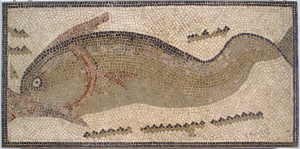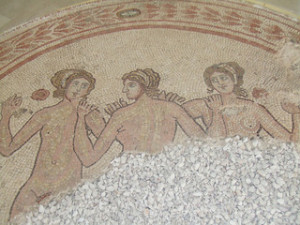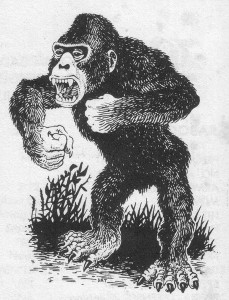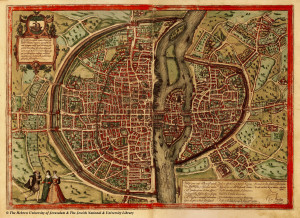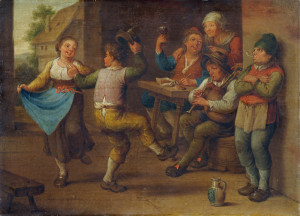[This is the third post in a series of session summaries (i.e., a play report) for the first campaign I have run in the Curabel setting. Each summary was written by one of the players, but I am adding my own ‘DM Annotations’ on these write-ups before uploading them here. These annotations will mostly call attention to bits of the summaries that will be significant later in the campaign (with links to relevant summaries to follow as they are posted) or else explain my rational for my game-mastering choices.
Please note that the summary will be displayed as regular text and my annotations as block quotes throughout.]
Session Three
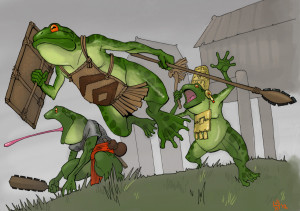
Bullywugs, by pachycrocuta-d51ltb8
It’s my turn to recap, so here we go!
This summary was written by Antony, who still plays the dwarf fighter Axel. He did not have much tabletop RPG experience, but picked it up very fast. This ability to pickup the game so quickly is especially noteworthy because he lives in England and plays from 1am to 5am his time and has rarely missed sessions.
We continue where we left off, outside of Desric’s shop after collecting the reward for handing him the plans to Talessin’s automatons. He told the party to go and see Elspeth [the proprietor] at the Cock & Bull.
All the names of NPCs and establishments in the City of Midmark were generated using a variety of random tables and scripts, most of which have now been posted to this blog.
Primarily, this happened one of two ways: for NPCs and places I know will be significant (or at least mentioned), I do the generation beforehand and flesh out some further unique details – this was the case for Elspeth and the Cock & Bull. For ‘surprise’ NPC appearances, like the random encounter with Ede Kynge mentioned in the next paragraph, I create large text files consisting of hundreds of NPC records. In that case, I just grabbed the first likely entry, which happened to be for a lamp maker. Alternately, though, I will take just the name and description of a random NPC from my list when the party seeks out a specific vendor or other individual (e.g., they want to find a locksmith, which shouldn’t be impossible in a large city, and I don’t have that specific NPC type at hand).
Before head over to the Inn, Galron stops an older man, hoping to procure a map of the city. The man, Ede Kynge, tells us that we are currently in the Adventurer’s Quarter, and that we can basically find anything we need along the main road here, West Copper Street. A paper market and bazaar are back towards the harbour, and Threehorn Way, an alleyway next to Desric’s shop, has an Alchemist’s.
Kynge, the proprietor of ‘Kynge’s Lanterns’, also urges Galron to try his shop as the Paladin is looking for a custom lamp. Further conversation reveals Talessin’s supposed involvement with foreign contacts, strongly hinted to be elves and perhaps not a good thing.
The party misread Kynge’s hints here – which were aimed at Talessin’s Imperial connection, although there was no reason for me to correct their mistake. The NPC, certainly, would be reticent to make such an inflammatory claim about a well-known wizard any more explicit.
After this, the party enters the Cock & Bull, where we find Elspeth the landlady. She doesn’t seem to think much of us, apparently having seen many a group in the employ of Desric, but offers us the townhouse behind the Inn, which we can rent for 30 Gold a month. The house, though sparsely decorated, is often used by adventurers helping Desric.
While renting rooms at an inn would have been adequate and within the party’s means, I thought it would help the group view Midmark as their ‘home’ if they had a more private (and somewhat more permanent) residence. At the same time, in more practical terms, having them rent a house also meant that NPCs hunting for the group could more easily track them down.
After some discussion, the party decides to trial it for a single night, paying a single gold (though Axel elects to stay in the Inn due to a lack of beds).
After a quick tour, Axel and Galron head out to run some errands, whilst the rest of the party stays at the Inn.
In this time, Ir’Alle approaches an elder elf, a sage called Ferri. He learns the location of a House of the Brotherhood [the temple for clerics of Xen’Teler, the dwarven deity], down at the harbour. In asking for people of importance in Midmark, he learns that Ferri is not a friend of Desric’s and suspects the Dwarf may be a supporter of the unease in the city towards its authorities.
This is an explicit reference to the tension between native islanders and colonial humans in Midmark. Ferri, whose mother killed herself after a long imprisonment by imperials prior to the liberation of the islands, is a strong advocate of the colonial aristocrats and their institutions – a ‘law and order’ type who sees any sacrifice of liberties as justified to prevent the return of the empire; Desric, on the other hand, is more understanding of the grievances of the native islanders (based partly on his research into the ancient dwarven empire’s treatment of their underclass as mentioned below).
Outside, Axel and Galron head first to the Alchemist’s. The shop is closed, but the owner, a rather attractive Halfling lady, humours us. Axel enquires after healing potions, but they are too expensive for the party to currently buy (450g each). The Alchemist begins to get annoyed, but calms down when we reveal our naiveté of such things, being new adventurers.
I tend to agree with DMs critical of ‘Magic Shops’ as something that cheapens the fantastical element of settings. There are always those who will purchase artifacts and magical items, collectors or various sorts and researchers, but having such items on shelves for the public to pick over seems wrong. However, I exempt from this items that could be explained via other means – like healing potions whose efficacy depends on alchemy rather than magic. These things are still expensive given the rare ingredients and secret knowledge needed to produce them, but they are completely natural phenomena.
We then head to the local Ark, whereby Galron donates a portion of his earnings to a friendly female cleric, hoping to secure discounted healing for the future. Axel matches the donation as a show of goodwill.
Back at the Inn, Thorfus asks a blacksmith [drinking in the common room] about acquiring better armour. The smith, Tylic Eraclid, admits he can only really do repairs, but recommends an elven armourer, Orsabet, down by the bridge.
I know some DMs and players look at this kind of ‘shopping simulation’ and see a giant waste of time. However, my experience is that when this type of play is used strategically, it enhances the players sense that they are dealing with a living world rather than a convenient backdrop for their heroics. Sometimes it is enough to tell players they can buy anything in the PHB for a 5% markup from nearby vendors (usually after they have already become acquainted with a city or town), but, as any traveler knows, shopping can be an adventure in itself and tell you quite a bit about a location. By the time they left Midmark, this group had a mental map key neighborhoods in the city and a list of contacts they could ask about items recovered in their adventurers — they treated it like a lived in place rather than a menu.
Sthorm also approaches Ferri, asking the Sage to appraise the book and wand he ‘acquired’ in secret from Talessin’s tower. He is unable to identify the wand, guessing that it could be defensive in nature. The book, he identifies for 70g, and cautiously reveals it to be a basic spell book, and offers to buy it for 270g. Sthorm keeps it for now.
The next morning, Axel ribs Galron about his actions towards the various women the previous day. Although he claims he is just trying to haggle and charm, we all know the young Paladin is a horny teenager. Axel offers to take him to a brothel, but he declines.
The party returns to Desric, where he offers us a job. After some bad luck, a party he sent to Xen’Khel half a year ago went missing. They had been on a mission to open a previously locked up area, but their disappearance destroyed any hope of finding it, as they had the only known key. Desric’s research turned up a second key though, and, several weeks ago, he sent Galdor’s Free Company to collect it from a tomb deep beneath the University in Midmark.
These paragraphs describe the moment when I introduced a rather big adventure hook – one that would eventually bring the party to the nearest mega-dungeon (the Xen’Khel ruin mentioned here). As the game approaches eighty sessions, the party is still dealing with the fallout of their acceptance of this job.
It is significant, though, that the hook actually consists of two parts – a starter dungeon located inside the current city and the mega-dungeon of Xen’Khel. That was purposeful and accomplished two things: first, it made the mission seem doable to the group despite their low level; second, it provided a natural place for a break from dungeon-delving between the starter and mega dungeons if they grew tired of that activity.
The tomb, a remnant of the ancient Dwarven city Midmark is built upon, is supposedly that of a high-ranking family. Galdor’s men managed to locate it, but turned back after they lost a man to trap.
Desric says that if we can finish the job, he would pay us 200g for the key, giving us looting rights to anything else we may find. The key is a disc, roughly 1’ in diameter, engraved with Ancient Dwarven runes. It is likely buried with the family matriarch. He gives us directions to the tomb, and also tells us that Galdor is staying at the Flotsam and Jetsam, near the harbour, should we need any more information.
Having some adventurers the party could pump for information before beginning their quest turned out to be a very good idea. When I ran this starter dungeon the second time, the group ignored this lead and had a much rougher time of things initially because they found themselves walking into the middle of a complex situation with no clues.
Sthorm privately asks Desric as we leave if he wants the book or wand, but the dwarf can only offer 50g for the un-appraised wand.
Following the main road towards the harbour, we stop of at Orsabet’s, where Thorfus commissions some chainmail, to be ready later that evening.
At Kynge’s Lanterns, Galron purchases a hooded lantern, made to hang from a pole, and several flasks of oil.
Next, the party stops at the paper market, where Sthorm seeks out a mage called Velten. He exchanges the spell book in order to get the wand appraised. Velten identifies it as a Wand of Magic Detection, and despite having minimal remaining charges, is probably worth 1000g or so.
The rest of the party finds Garviso, who sells maps, from which we purchase maps of the city and the island of Curmidden.
The group caught me a bit unprepared here – I hand-draw all my maps and didn’t have any scanned copies to share immediately. In addition, the city map contained a bit too much information and needed to be redone for their consumption. Since we were playing online, it wasn’t possible to scribble something for reference while they waited, so I apologized and promised to upload the documents to our campaign’s G+ community page during the upcoming week (which I did).
Ir’Alle takes us then to the House of the Brotherhood to pay his respects. The dwarven cleric he speaks to seems to have heard of him, as a human in a dwarven religion is a bit of an oddity. When asked if Ir’Alle can offer any assistance, the dwarf asks that we see if we can uncover a missing group of surveyors, patrons of the House, lost in a swamp near the city of Vargen.
Although I thought the starter dungeon was the natural next step for the group, the campaign is not a railroad and it was important for me that they had other choices. This adventure hook gave them another choice, although they never followed up on it.
After asking for further directions, we reach the Flotsam and Jetsam. Enquiring after Galdor, the man is brought to us. When asked about the tomb, he tells us it is dangerous, and it is probably better not to go at all. His group, although used to lighter work, are veterans, but they still lost a man to a revolving floor trap.
Further questioning reveals that they had to drive out a Goblin settlement in order to get to the tomb and that their path was marked in chalk, denoted by the initials GFC. He also claims the tomb was weird, full of odd stains and strange noises.
Understanding the significance of the chalk marks and not being surprised by the goblins’ presence were the big advantages of the party speaking with Galdor. The latter fact was probably especially important to making the party’s deal with the goblins possible and letting them avoid an unnecessary fight.
The party decides to spend the rest of the day preparing. We hire a pair of crossbowmen on Galdor’s recommendation, Sturloc and Kottar. The barkeep also points us towards an eager young boy, Kilmar, who we hire to be a torchbearer. Galron promises to buy the boy a proper weapon after the mission.
The party’s first hirelings! While my games as a teenager rarely (if ever) involved hirelings, I wanted this campaign to be a more authentic 1E AD&D experience in this regard – fortunately, some of the more experienced players already understood the benefits of hirelings. These two crossbowmen have been with the party ever since (although one has been possessed by an ancient Devil Fish spirit for the last twenty or so sessions) and the original players are very attached to them despite the fact that they rarely contribute except as treasure bearers. Kilmar’s fate, on the other hand, was not as fortunate.
Returning to Desric, the dwarf admits the tomb possibly could have automated guardians and strong magical protections and traps. In this time, Sthorm sells Desric the wand for a large sum. After Thorfus collects his armour, the party stays again at the Cock & Bull, finally deciding to rent the house for a month.
The next day, we meet the hired help at the sewer entrance, supplying Kilmar with a lantern and a backpack. Entering the sewer, the party finds itself in a chamber housing the remnants of Galdor’s camp, denoted by GFC C1/30.09 written on the wall. Following the only tunnel in single file, we head roughly south, following further chalked signs and descending deeper until we find a cave-in mentioned by Galdor.
Climbing down a steep incline, we see the beginning of the ruins, with what looks to be the mosaic walls of a dwarven bathhouse. The party notes the smell of salt water and something else more foul. Entering a large chamber, we can hear the sound of falling water, and (momentarily) the keen of what could be a wounded animal. Opening a door, Goblins suddenly appear behind the group, brandishing weapons and calling for us to leave.
The summary here glosses over the details, but I used these mosaics (and other architectural features of the bathhouse) to begin establishing the nature of the ancient dwarven empire. Primarily, I wanted it to be clear to the group that those dwarves used humans (and perhaps other races) as slave labor and had little respect for their dignity. This speaks to the importance, I think, of making sure important clues are repeated to emphasize their significance — as later comments reveal, the repetition of the motifs in the mosaics elsewhere eventually caught the party’s attention.
The goblin speaking members of the party manage to talk to the Goblin leader, discovering that we were thought to be Galdor’s men returning to finish them off. Because of this, and the loss of several warriors, the goblin tribe had lost its home to a band of ‘Frogs’, led by the ‘Bad Fish’.
This would be a large group of Bullywugs led by a Devil Fish. As mentioned in my notes on the first session, I had already established the threat posed by the Devil Fish via the wrecked ship encountered as the party entered the city. Meanwhile, I decided to use some of the racial notes on Bullywugs published on Hack & Slash’s blog, making them misogynistic sadists. Hack & Slash’s ecology piece on Ixitxachitl also figured into my conception of the Devil Fish.
After some discussion, the Goblins agree to let us into the tomb, but only if we help them retake their home in the main bathhouse from the Frogs. Following the leader into a smaller chamber, a second band appears from the room we tried to enter, effectively surrounding us.
The Goblin tells us how they have blocked most of the passages after several skirmishes, trying to force the Frogs into attacking from only a single direction. If we attack the Frogs, the Goblins will unblock one of those passages and ambush them from behind. In this time, we see another room with mosaic’s depicting the place of humans in the ancient dwarven kingdoms, that of possibly slaves and servants.
Here it starts to become clear to the players that they cannot make assumptions about who is an ally or enemy based solely on alignment – it’s probably also true that this is when the Galron the paladin’s player began to consider rolling an alternate character. I would not have actually penalized his character in this case — allying with the goblins served a greater good — but it’s possible he saw this situation as indicative of future problems.
As mentioned earlier, this is also where the benefit of repeating important facts/hints is made evident – the subject matter of the initial mosaics did not make enough of an impression for inclusion the summary, but the repetition of the theme caught Antony’s attention here.
We decide to assist the Goblins, and the leader takes us to a set of double doors to the East, following the flow of water. At the door, Galron sense evil beyond, and we push them open to reveal a balcony from which the water falls [into a pool in the large room below]. Upon the balcony, a rather crude and disgusting statue made from the body parts of slain Goblins sits directly in front of the doors along with a Frog.
The first evidence of the Bullywugs’ sadism in the form of some (goblin) body horror.
We attack it instantly, and, after a few seconds of struggle, the Goblin leader caves the creature’s head in with his morningstar. During the scuffle, Galron is able to detect the Goblins alignment. The Goblin turns out to be evil, rendering the paladin unable to assist it in any way, for fear of losing his powers.
At the beginning of the next session, this goblin will leave to accommodate the paladin’s restrictions, although the indirect help provided by the goblin’s flank attack goes ahead (with no penalty to Galron).
We end the session stuck with that dilemma, hearing a final croak from the darkness in the room beyond.
A little bit of a cliff-hanger to end the party’s first real dungeon-delve session.
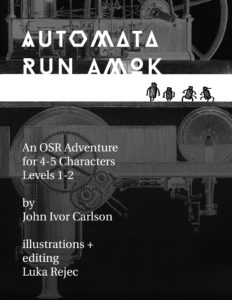 This blog has suffered severe neglect in recent months, although my RPG-related activities have continued unabated. Besides my ongoing first edition campaign (which recently surpassed five hundred hours of play), I have also been working hard on converting some of that game’s early adventures into publications. The first such adventure is the incident at the tinkerer-wizard Talessin’s tower (see the annotated play reports: first session and second session).
This blog has suffered severe neglect in recent months, although my RPG-related activities have continued unabated. Besides my ongoing first edition campaign (which recently surpassed five hundred hours of play), I have also been working hard on converting some of that game’s early adventures into publications. The first such adventure is the incident at the tinkerer-wizard Talessin’s tower (see the annotated play reports: first session and second session).

